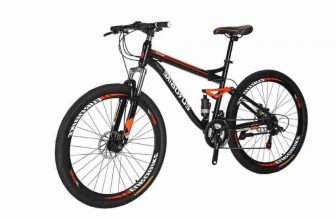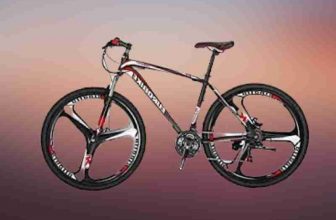
If you’re considering taking up mountain biking as a form of exercise or have already begun, you might be wondering if it’s harmful to your back. Nothing is worse than back pain, and I mean nothing. So, before getting too involved in it, it’s a good question to think about.
Mountain biking isn’t necessarily harmful to your back. Poor alignment, tight hips, a weak core, a poorly built bike, or a crash, on the other hand, can all lead to back pain in mountain biking over time.
As you can see, mountain biking is no more likely than a range of other regular everyday tasks to cause back pain. There are, however, some precautions you can take to guarantee that it is a fun and pain-free type of exercise!
Why Does Mountain Biking Harm Your Back?
Bicycling is a popular activity that has been adopted as a sport worldwide. While some people use it to relieve lower back pain, others claim it is the source of their discomfort. Is it, however, correct?
It’s important to note that mountain biking is not without its difficulties. Numerous possibilities could result in back pain, ranging from carrying gear to the case of wrecks.
However, there are a few key considerations to consider:
The upright position of a mountain bike fosters and facilitates excellent posture more quickly than the hunched-over position of a road bike.
During rides, it requires a variety of body positions and movements to prevent overuse.
It’s a contact-free sport, and you have complete control over what you ride, where you ride it, and whatever hurdles you tackle.
To alleviate back strain, water, tools, and practically all backup gear can be offloaded to the bike’s frame.
In a standing position
Mountain riding, in particular, allows you to maintain an incredibly upright posture. It’s far easier on your body than road biking, where riders find themselves hung low over the handlebars.
You can also change and adapt your bike’s set up to accommodate any discomfort or wants. A fitting at your local bike shop can soon pay for itself in this situation, and they may aid you in getting each measurement just where it should be.
Movement of the Body
Mountain biking, unlike road biking, necessitates maneuvering one’s body around the bike to navigate numerous trails successfully. You don’t spend too much time in one position because you’re constantly moving up and down and around the bike.
This is incredibly beneficial for maintaining blood flowing throughout the body and lowering the risk of overuse injuries due to the variety of exercise.
Non-Contact Sport
The notion about “non-contact” sports may seem absurd. Still, when you compare mountain biking to most team sports, such as basketball, as a form of exercise, you’re considerably less likely to get harmed due to accidental (or intentional) contact.
Slamming into someone or landing awkwardly after a leap is a particular method to aggravate a muscle in your back. This is especially true if you fall into the “weekend warrior” category, which many of us do.
While a collision is certainly possible, you rarely have to put yourself in that situation if it’s a serious concern. You can gradually progress to more challenging trails as your technique and skills improve, and you should never hurry into anything.
Distribution of Weight
Finally, don’t forget that you don’t have to carry everything yourself. While bringing a Camelbak for your water or a small backpack to carry snacks or tools is a good idea, it’s not required!
Allow that hulking bike frame to shoulder some of the weight for you – literally!
Purchase a saddle bag to store tools and snacks, as well as water bottle mounts to relieve at least some of the weight from your back.
What are the dangers associated with mountain biking?
Mountain biking, even for recreational purposes, is not without dangers. Aside from the fun you’ll probably have on the cycling route, you’ll want to be aware of and protect yourself from the potential risks you’ll encounter.
While most of these dangers will only result in minor or no damage to the rider, others may result in career-ending injuries. Let’s take a closer look!
Mountain riding entails cruising through valleys and pedaling upward, as the name implies. The chosen route may not be particularly welcoming, especially if this is your first bike vacation.
The bicycle path is frequently rough, contains steep twists, and maybe covered in gravel. During the rainy season, your bike will slip multiple times, and you will have to pick yourself up off the ground.
As a result, the terrain combined with wet weather may be a prescription for disaster. Falls can result in various injuries, including minor scrapes, broken limbs, and head traumas, to name a few. As you might expect, wearing a helmet or other protective gear will not prevent some of these injuries.
The potential of spinal injury is high on the list of dangers associated with mountain biking, and the number of persons reporting spinal problems due to bicycling is growing by the day. The most common cause of such injuries is falling steep slopes, but other possibilities exist.
For example, on a long bicycle trip, you’ll be carrying a backpack full of essentials. Given the necessity for water, bike spares, and tools, such a kit may weigh more than 10 kg.
Poor pack setting on your back might cause pain in your lower back, resulting in intermittent pain.
Aside from spine problems, you should be aware that a mountain biking train includes steep slopes and abrupt or blind turns near the bottom of the hill. Riding downhill at high speeds may appear to be fun, but the danger of colliding with other riders or stationary objects renders it useless.
People still rush through the sharp turns, falling to the ground and injuring themselves.
Why does my lower back hurt when I ride my mountain bike?
Many mountain bikers feel lower back pain after or during a ride. You’ll need to consider the following factors to determine why your back hurts.
First and foremost, are you riding the proper bike for you?
To alleviate back pain, you should ride a bike appropriate for your height. A bicycle with too high saddles or too low a seat, for example, may force your backside to lean from side to side as you bike through the route.
Furthermore, if the handlebars are too wide or too low for your arms, you will be putting unnecessary strain on your arms, which may lead to back pain.
Second, how comfortable you feel after a ride is influenced by your riding posture. It would be beneficial if you remembered to keep your back straight rather than bending it outwards as most riders do.
As a result, the bones in your spine and lower back will stay aligned in the proper places, resulting in less stress. This, along with stiff hips, causes needless lateral motions, which can cause lower back pain.
The third reason for lower back pain is due to poor body mechanics. People who haven’t exercised in a long time, for example, are more likely to develop lower back pain after mountain biking than those who regularly exercise and ride. As a result, you should plan ahead of time and begin practicing before embarking on your first mountain bike adventure.
Finally, weak core muscles are one of the causes of lower back discomfort.
Mountain biking puts more emphasis on the hands, legs, and hips than on the lower back and abdomen. While the arms and rib cage support the upper back and the pedals support the hips, weak abdominal muscles frequently endorse the lower back.
This can be the start of a problem, especially if you’re bicycling with a hefty backpack.
How can you get rid of lower back pain?
Improve your cycling skills.
The first step in resolving lower back discomfort caused by mountain biking is selecting a bike appropriate for your body size. A narrow bike seat or high pedals, as we previously stated, are pain-inducing and should be avoided at all costs.
Additionally, choosing a bike with medium-width handlebars can help alleviate your pain.
Reduce the amount of luggage you carry on your back.
A backpack will almost always be required. On the other hand, some new options can help you pack lighter and carry less on your back.
Attaching one or two bottle cages to the bicycle frame, for example, will reduce the backpack’s weight by at least 1 kilogram.
Furthermore, purchasing clothing with pouches for carrying spares and tools can significantly reduce the pack’s weight, making it easier on the lower back.
Before you ride your bike on the road, get some exercise.
Two years ago, you were probably mountain riding, and that does not qualify you to get up and join your friend on the route because he invited you.
Instead, you make the appropriate preparations and ride around the neighborhood for approximately a week. Additionally, scouting the route ahead of time will help determine the amount of stress the workout will place on your muscles and plan.
Make improvements to your pedaling technique.
We’ve already explained how bad pedaling skills might cause lower back pain. As a result, you should reconsider your cycling abilities and habits to avoid the problem.
It’s possible that you’ll need to adjust your posture and how you grip the handlebars, among other things. If the bicycle road is long or you’re carrying a big backpack, pedaling while standing after a time can help relieve back stiffness.
Strengthen your core muscles.
When you’re riding up or downhill, your lower back is supported by your core muscles, and they assist with keeping the lower back in a normal position, preventing pain caused by poor riding posture.
You may need to seek a skilled sports physiotherapist or a trained physical therapist to show you how to best improve your core muscles.
Make contact with a bike trainer.
If you’ve been pedaling for a while and the pain isn’t going away, it’s time to seek the help of a bicycle trainer. A skilled trainer can assess your trail moves and determine what’s wrong with your back.
Even with professional assistance, you must avoid unhealthy habits like carrying too much weight on your back and bending your back when pedaling.
Mistakes that put you at risk of lower back discomfort
Gripping the handlebars too tightly: You need to grasp the handlebars for support and control, but too much grip makes your hands stiff, which adds to the pain. We’ve already mentioned that a firm grip pushes you to stretch your body outwards, leading to lower back pain.
Maintaining a collapsed chest: Many bikers have a collapsed chest. The problem is comparable to that of day-to-day office workers; you may overcome it by practicing keeping your shoulders drawn back and low while you are not riding your bike. Hunched shoulders may exacerbate your lower backache.
Riding the course while seated: If you have a bag on your back, it is best to pedal while standing while ascending uphill. Standing helps to relieve pain by distributing the weight of the pack. This may not always be a possibility depending on the hill’s steepness, but it’s worth considering!






